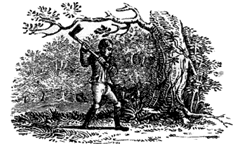|
|
 |
The Davis family of Solomons takes a break from eating and enjoying We The People Give Thanks, a Thanksgiving program of readings, rituals and songs rooted in national history.
photo courtesy of Marc Apter |
We the People Give Thanks: A New Thanksgiving Tradition?
It’s Thanksgiving afternoon and 17 Davis family members from three to 76 years old are chatting, singing, running and cooking in anticipation of their family Thanksgiving meal. It’s normal Thanksgiving bedlam.
A good half hour before the meal is served, they sit down as one of 400 Maryland families testing a new Thanksgiving tradition born out of September 11’s tragedy. We the People Give Thanks is a Thanksgiving dinner program of readings, rituals and songs rooted in national history. It centers on the Declaration of Independence, the Bill of Rights and the Constitution.
The program’s creator, Lee Hendler of Baltimore, thought that after September 11 the country was ready for a reaffirmation of its core values within the holiday. She and a few associates wrote and printed 5,000 booklets to test the concept.
Hendler calls the Declaration of Independence one of our nation’s sacred texts. “It struck me that we needed to create a ceremony that would enable people in a non-preachy way to reconnect to these texts,” she said. “We tried to keep it to 30 minutes and hope that next year it will be on every American’s Thanksgiving table.”
Each person at the Davis table in Solomons recounted what they were blessed with in the past year. Michael Davis, 38, of Kensington, said, “I’m so thankful that my kids can live normal lives without worrying about land mines and sniper fire. It is because our democracy solves our problems in legislatures and courts, not on the battlefield.”
To keep youngsters focused, the service borrows a ritual from the Jewish Passover tradition: the search for a hidden prize. The program begins with a presentation on the patriotic and educational symbolism of the dollar bill; then a bunch of dollars are hidden, to be found by one of the children. Kyle Davis, 9, found the money and earned the honor of deciding which charity it should go to. His answer showed that he’d been listening to his elders during the service. “Lets give it to the hungry people in Afghanistan,” he said.
As the ecumenical service continued, Ken Davis, 47, the chef for the day’s bountiful table and the family cynic, walked in and demanded, “when is this séance going to be over?” His attitude seemed to be in the minority.
During the service and after dessert, the group sang such traditional American songs as “America the Beautiful,” “Clementine,” “God Bless America” and “Over the River and Through the Woods.”
“The songs were a light-hearted yet traditional touch to the seriousness of the subject. Most of us joined in with gusto,” said Meg Davis, 41, of Solomons, host of the dinner.
Another youngster liked recounting his version of the Pilgrim story. Scott Patrick Abell, 7, told how “about 51 Pilgrims came over on the Mayflower and bumped into the Indians. They had a party for three days to show how glad they were to have land to live on.”
Peggy Davis, family matriarch, called the round of personal thanks “emotional and heart warming.” Still, she said, the service “will never work nationwide because most people won’t change their traditions.”
Younger members disagreed. Meaghan Abell, 12, said she loved the addition to her family’s Thanksgiving day. “It was such a neat idea. I particularly liked the part where we took items from the cornucopia and discussed their symbolism,” she said. Acorns represent Native Americans, corn symbolizes the arrival of the Pilgrims at Plymouth Rock in 1620, peanuts represent the slaves brought here against their will, and bagels and fortune cookies represent our ethnic diversity.
Dot Davis, 51 of Germantown, enjoyed “the sharing and being reminded of what’s important in our history and core ideas. It helped us to get in touch with the true meaning of Thanksgiving,” she said.
The most enthusiastic response came from Diane Davis Gerber, 46, of Woodbine. “It was wonderful and a long time coming,” she said. “We have never as a family expressed what we are thankful for except for the usual rote prayer. September 11 has made us take stock of all the things we really value.”
The family patriarch, Jim Davis Jr., of Hollywood, had the last word: “Since September 11, we are inclined to be more appreciative of all that we have and reaffirm that we are one nation, under God, indivisible, with liberty and justice for all. That pretty much says it all.”
Information? 410/363-4135.
— Marc L. Apter
 Deck the Halls with Gifts from Trees Deck the Halls with Gifts from Trees
Long have trees, especially evergreens, lent special meaning to the seasons of Christmas and winter solstice. Even children grasp their symbolism of fresh life. In a year scarred by tragedies, such symbols are most welcome. Yet more gifts come from trees than garlands and wreaths. Here are a few more ways to affirm life with tree-themed gifts.
Books about Trees
Children’s tree books abound. Some show children how to care for trees, so it’s well to also give a small tree they can grow up with. Some help identify leaves and trees. Some explain how trees grow and live, making a possible prelude to later birds-and-bees talks. Some are allegories, such as Shel Silverstein’s classic The Giving Tree. One nice annotated collection of children’s books, with a link for online purchasing, is at TreeLink, www.treelink.org/linx.phtml?type=1&sub=5.
Still other books help adults share trees and nature with children. A favorite among these is Joseph Cornell’s acclaimed Sharing the Joy of Nature: Nature Activities for All Ages, with its audio accompaniment, A Sharing Nature Walk: Nature Games for All Ages. Then there are stories of tree heroes like Johnny Appleseed and John Muir, celebrated in Cornell’s John Muir: My Life with Nature.
Woodcrafts
The fresh, intoxicating aroma of wood is a gift in itself. Most every town of any size in Chesapeake Country has at least one quaint gift store featuring such items.
Nativity scenes and wooden wreaths are charming seasonal choices. Lighthouses, nautical figures and decoys are perfect in Chesapeake Country. Lamps made from tree branches and wooden branch displays remind a recipient of the gift’s origins. Then there are carved garden and house markers, stash boxes and bowls.
Varnished wooden baby blocks, trains, dollhouses and puzzles have it all over plastic ones. Crafts stores carry them, as well as unfinished toy boxes or stools for children to paint. Start children older in age or heart on a hobby with a woodburning or woodcarving set.
Carved home décor and furniture is distinctive: clocks, coat pegs, magazine racks, umbrella stands, chairs, coffee tables, curio cabinets, flag and display cases and cradles. For a unique gift, give a certificate for the services of a woodworker to custom-make bookshelves, paneling, shutters or flower boxes — perhaps filled with wooden tulips or woodcurl roses.
You’ll find custom woodworkers in Bay Weekly ads, and carvers are listed in the Yellow Pages. They also appear throughout the year at craft shows. The Chesapeake Woodturners, for instance, will host demonstrations and sales at Behnke’s Nurseries the first two weekends in December and again at the Maryland State Fair Grounds in Timonium January 4 to 6, in time for gifts to close the 12 Days of Christmas.
Tree Care Amenities and Accouterments
For those on your list with a yard, the gift of a hammock will help them appreciate their trees all the more. And imagine the joy of a youngster who receives an old-fashioned wooden swing or treehouse.
A tall pruner can be especially welcome as trees get taller. Ergonomically handled rakes make seasonal leaf work less painful, as would a certificate for the services of a leaf-raker, perhaps a reliable teen needing to earn spending money. Wood-strip bushel baskets, available at old-time hardware stores like Bowen’s in Annapolis, are terrific to hold everything from groceries to boots or newspapers. Log holders and canvas log carriers are good for those with fireplaces.
Do-It-Yourself Gifts
On a shoestring budget? Chesapeake Country is blessed with a variety of raw tree resources for the taking. With spray paint or glitter, pine cones and sweet gum burrs can become stunning creations for decorations or permanent accouterments like picture frames or window valences.
Dipped in fragrance, cones also become aromatic fire starters or potpourri. Washed-up driftwood morphs into a one-of-a-kind sign or tray. A game could even be made up from scratch such as a twig toss with colored sets of twigs for each player.
Live Trees
Last but not least of the tree-themed gifts are live trees. These gifts truly keep on giving. Trees beautify a yard or house interior. They can also grow along with young children. Pictures of children beside their trees over the years become cherished memories.
Local nurseries can help in the choice of a seedling or sapling. So can Trees for Life (800/873-3736), which offers a kit with tree seeds, instructions for growing, a tree starter carton and other goodies. With each kit, 25 fruit trees are planted in the child’s name in developing countries, as is noted on a certificate with your gift.
If you’re giving a gift to someone who’s lost a loved one this year, think of a memorial tree. You can play Santa, showing up with tree and shovel. Or you can order a tree planted as a memorial. One resource is Heifer International, which sends trees to impoverished areas of the world (800/422-0474).
— Patricia Kirby
 Let Your Light Shine; Don’t Let it Burn Let Your Light Shine; Don’t Let it Burn
A fiberglass Rudolph with nose aglow stands by the walk adjacent a radiant Santa. Inside, mom is busy arranging candles whilst dad untangles the gnarl of last year’s tree lights. Elsewhere, Hanukkah’s menorahs will soon take their places, as will the candelabras of Advent and Kwanzaa.
Whether through pious glow or kitschy gleam, the early night of holiday season begs to be illuminated. It’s a call we gleefully heed, raising spirits along with our electricity bills.
But take care when decking halls and home with light. According to Underwriters Laboratories, 3,110 people nationwide were sent to the emergency room last year by electrical decoration mishaps. The Office of the Maryland State Fire Marshal reports that in 1998, the most recent year it has numbers for, 189 candle fires flared across the state.
Here find a few tips for safe lighting — gathered from the Office of the Maryland State Fire Marshal, Underwriters Laboratories and the National Fire Protection Association — so you don’t find yourself roasting chestnuts o’er the open fire that was your house:
- Put out all candles when leaving the room. Extinguish all candles and light strings before bed or leaving the house.
- Keep candles away from kindling such as clothes, books, papers, curtains, drapery, Christmas trees, combustible decorations or anything else that can burn.
- Don’t let kids or teens have candles in their bedrooms.
- Keep candles and any electrical decorations out of reach of small kids and pets.
- Place candles on steady furniture and in sturdy, non-combustible holders large enough to gather dripping wax.
- Avoid candles with flammable materials embedded in them.
- Don’t overload extension cords with light strings. Check the strings’ tags for the maximum number of strands that can be joined together.
- When unpacking your stringed lights, check for frayed or bare wiring, cracked sockets and loose connections: They can cause electrocution or fire. Do any maintenance with the strands unplugged.
- Light strings for indoors-only use bear a green Underwriters Laboratories (UL) logo on the tag; indoor/outdoor strings bear a red logo.
- Inspect the needles of live or cut trees and greens before buying. If they’re brittle or brown, they pose a fire hazard. At home, keep the tree watered and in a non-tip stand at least three feet from the fireplace.
- Never use lit candles to decorate your tree.
- Get more safety tips for a sound holiday season from the Office of the Maryland State Fire Marshal at 800/525-3124; Underwriters Laboratories at www.ul.com/consumers; the National Fire Protection Association at www.nfpa.org.
— Mark Burns
 In Season: In Season:
White-Throated Sparrow
Story & drawing by Gary Pendleton
In fall, many birds have gone silent or left for warmer latitudes. A few of the songbirds remain quietly behind, and they are joined by a small number of species that will quietly spend the colder months here in what passes for a winter haven.
In this break from the season of song, let’s consider what makes a songbird.
By one way of looking at it, a songbird is simply a bird that sings. Scientifically, the very large group of birds commonly known as songbirds are referred to as Oscines (OSS-ih-neez).
Oscines are the largest sub-order of the largest order of birds, the Passerines, or perching birds. So songbirds are perching birds.
In North America, the only perching birds that are not technically considered songbirds are flycatchers. Flycatchers are sub-oscine passerines. Aren’t you glad you asked?
Crows, which are excellent perchers, are not known for their singing ability. These biggest of all the oscine passerines are indeed considered songbirds. So are nuthatches, creepers and swallows, all birds not known for the quality of their song.
The white-throated sparrow is a small passerine that overwinters in the eastern and southern states. It is well known for its song, which it occasionally sings even in winter, far from its breeding grounds in the northern United States and Canada. It typically sings two short notes followed by three long, quavering notes, producing a very musical sound. The notes are clear with a plaintive tone. You’re especially likely to hear one when days are warm and sunny.
The white-throated is bright for a sparrow, with yellow spots, called lores, adjacent to the upper bill, plus white stripes on the head and, of course, a white throat.
It may be true that all songbirds sing to advertise their interest in mating, but it is not true that all bird songs are musical. Perhaps only the wood thrush has a better reputation than the white sparrow as a vocalist.
Way Downstream …
In Virginia, three shipyards near Roanoke were accused last week of releasing a toxic chemical into the sewers. Authorities worry that the barnacle-repelling paint additive, TBT — so toxic that it might be banned worldwide — might be making its way into Chesapeake Bay …
In Prince William County, Va., a slow-growth plan put together by an all-white citizens group has riled black families who never were consulted, the Washington Post reports. Why? Because it calls for an African American Heritage Park, in which residents would be prohibited from making decisions about land that has been in their family for generations...
In New Orleans, a lonely orangatan named Berani may have found heaven. According to the Miami Herald, the three-foot-tall fellow has been transferred from the Miami Metrozoo to the Audubon Zoo in New Orleans, where he has met his true love, an orangutan named Mama. Waiting in the wings are two more hairy honeys, Feliz and Blaze …
 Our Creature Feature comes from Afghanistan, where the tale of Marjan the lion shows that not just people are victims of war. Amid relentless bombing, Marjan lies in his Kabul zoo cage, blind and lame as a result of an incident during fighting in the early 1990s when a soldier climbed in Marjan’s cage. Our Creature Feature comes from Afghanistan, where the tale of Marjan the lion shows that not just people are victims of war. Amid relentless bombing, Marjan lies in his Kabul zoo cage, blind and lame as a result of an incident during fighting in the early 1990s when a soldier climbed in Marjan’s cage.
Reuters reported succinctly what happened next: Marjan ate him. The next day, practicing revenge Afghani-style, the soldier’s brother lobbed a grenade at the lion, injuring him severely. Like Afghanistan, the future of Marjan and the zoo is unclear now that the Taliban have fled Kabul.
Copyright 2001
Bay Weekly
|